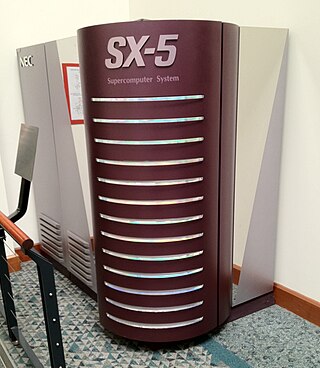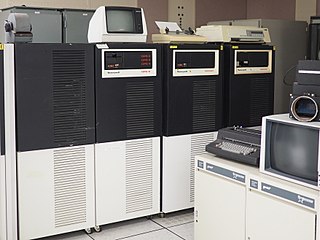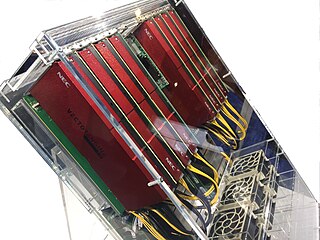
Multics is an influential early time-sharing operating system based on the concept of a single-level memory. Nathan Gregory writes that Multics "has influenced all modern operating systems since, from microcomputers to mainframes."

A mainframe computer, informally called a mainframe or big iron, is a computer used primarily by large organizations for critical applications like bulk data processing for tasks such as censuses, industry and consumer statistics, enterprise resource planning, and large-scale transaction processing. A mainframe computer is large but not as large as a supercomputer and has more processing power than some other classes of computers, such as minicomputers, servers, workstations, and personal computers. Most large-scale computer-system architectures were established in the 1960s, but they continue to evolve. Mainframe computers are often used as servers.

Non-uniform memory access (NUMA) is a computer memory design used in multiprocessing, where the memory access time depends on the memory location relative to the processor. Under NUMA, a processor can access its own local memory faster than non-local memory. The benefits of NUMA are limited to particular workloads, notably on servers where the data is often associated strongly with certain tasks or users.

Computer operating systems (OSes) provide a set of functions needed and used by most application programs on a computer, and the links needed to control and synchronize computer hardware. On the first computers, with no operating system, every program needed the full hardware specification to run correctly and perform standard tasks, and its own drivers for peripheral devices like printers and punched paper card readers. The growing complexity of hardware and application programs eventually made operating systems a necessity for everyday use.
The Honeywell 6000 series computers were rebadged versions of General Electric's 600-series mainframes manufactured by Honeywell International, Inc. from 1970 to 1989. Honeywell acquired the line when it purchased GE's computer division in 1970 and continued to develop them under a variety of names for many years. In 1989, Honeywell sold its computer division to the French company Groupe Bull who continued to market compatible machines.
The GE-600 series was a family of 36-bit mainframe computers originating in the 1960s, built by General Electric (GE). When GE left the mainframe business the line was sold to Honeywell, which built similar systems into the 1990s as the division moved to Groupe Bull and then NEC.
General Comprehensive Operating System is a family of operating systems oriented toward the 36-bit GE/Honeywell mainframe computers.
Cray Inc., a subsidiary of Hewlett Packard Enterprise, is an American supercomputer manufacturer headquartered in Seattle, Washington. It also manufactures systems for data storage and analytics. Several Cray supercomputer systems are listed in the TOP500, which ranks the most powerful supercomputers in the world.

NEC Corporation is a Japanese multinational information technology and electronics corporation, headquartered in Minato, Tokyo. The company was known as the Nippon Electric Company, Limited, before rebranding in 1983 as NEC. It provides IT and network solutions, including cloud computing, artificial intelligence (AI), Internet of Things (IoT) platform, and telecommunications equipment and software to business enterprises, communications services providers and to government agencies, and has also been the biggest PC vendor in Japan since the 1980s when it launched the PC-8000 series.

Bull SAS is a French computer company headquartered in Les Clayes-sous-Bois, in the western suburbs of Paris. The company has also been known at various times as Bull General Electric, Honeywell Bull, CII Honeywell Bull, and Bull HN. Bull was founded in 1931, as H.W. Egli - Bull, to capitalize on the punched card technology patents of Norwegian engineer Fredrik Rosing Bull (1882–1925). After a reorganization in 1933, with new owners coming in, the name was changed to Compagnie des Machines Bull (CMB). Bull has a worldwide presence in more than 100 countries and is particularly active in the defense, finance, health care, manufacturing, public, and telecommunication sectors.
SUPER-UX was a version of the Unix operating system from NEC that is used on its SX series of supercomputers.

NEC SX describes a series of vector supercomputers designed, manufactured, and marketed by NEC. This computer series is notable for providing the first computer to exceed 1 gigaflop, as well as the fastest supercomputer in the world between 1992–1993, and 2002–2004. The current model, as of 2018, is the SX-Aurora TSUBASA.
The Worldwide Military Command and Control System, or WWMCCS, was a military command and control system implemented for the command and control of the United States military. It was created in the days following the Cuban Missile Crisis. WWMCCS was a complex of systems that encompassed the elements of warning, communications, data collection and processing, executive decision-making tools and supporting facilities. It was decommissioned in 1996 and replaced by the Global Command and Control System.
GXS is a subsidiary of OpenText Corporation headquartered in Gaithersburg, Maryland, United States. Its GXS Trading Grid managed more than twelve billion transactions in 2011. Since 2004, GXS has invested more than $250 million in GXS Trading Grid. As of March 16, 2012, more than 550,000 businesses connect to GXS Trading Grid and, on average, more than 2,000 new businesses join each month.
PTC Scheduler is a Windows based batch scheduling application. Via the use of either "Agents" or Telnet connections, PTC Scheduler is able to schedule and monitor batch processes on the following platforms:
The Swiss National Supercomputing Centre is the national high-performance computing centre of Switzerland. It was founded in Manno, canton Ticino, in 1991. In March 2012, the CSCS moved to its new location in Lugano-Cornaredo.

Japan operates a number of centers for supercomputing which hold world records in speed, with the K computer becoming the world's fastest in June 2011. and Fugaku took the lead in June 2020, and furthered it, as of November 2020, to 3 times faster than number two computer.

The Honeywell Level 6 was a line of 16-bit minicomputers, later upgraded to 32-bit, manufactured by Honeywell, Inc. from the mid 1970s. Honeywell literature for Models 6/06, 6/34 and 6/36 say "Series 60 ". In 1979 the Level 6 was renamed the DPS 6, subsequently DPS 6 Plus and finally DPS 6000.

The NEC SX-Aurora TSUBASA is a vector processor of the NEC SX architecture family. Unlike previous SX supercomputers, the SX-Aurora TSUBASA is provided as a PCIe card, termed by NEC as a "Vector Engine" (VE). Eight VE cards can be inserted into a vector host (VH) which is typically a x86-64 server running the Linux operating system. The product has been announced in a press release on 25 October 2017 and NEC has started selling it in February 2018. The product succeeds the SX-ACE.









